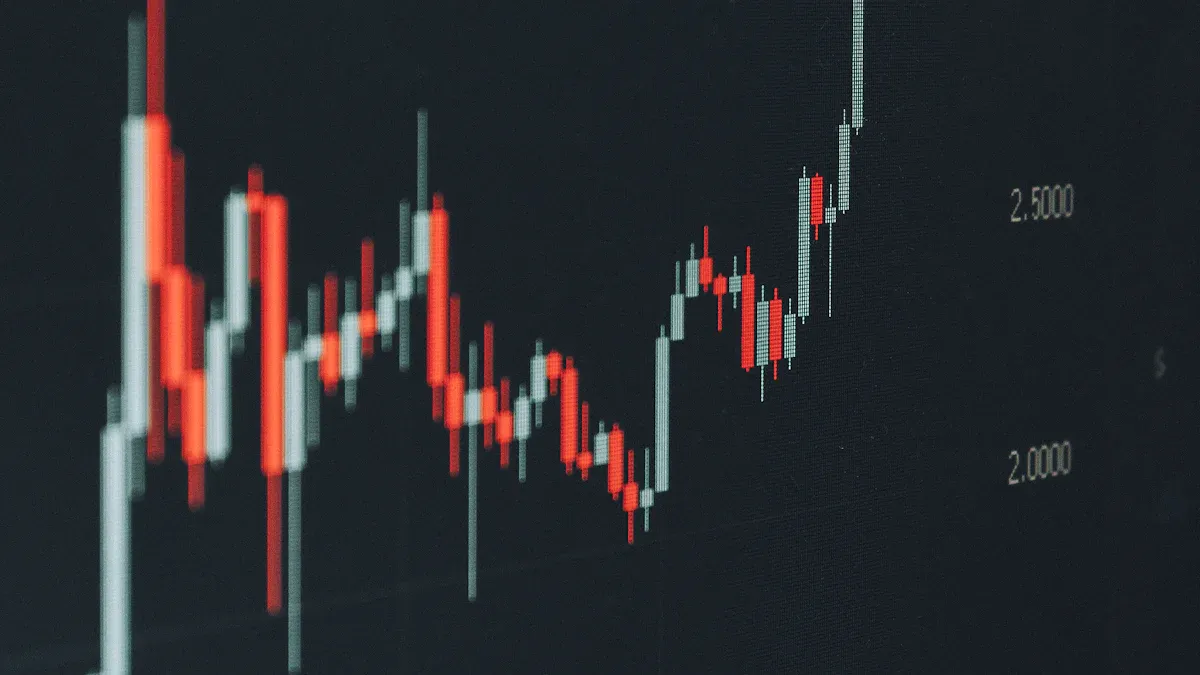- EasyCard
- Trade
- Help
- Announcement
- Academy
- SWIFT Code
- Iban Number
- Referral
- Customer Service
- Blog
- Creator
Stock Heat Map: A Must-Know Market Analysis Tool for Investors

Image Source: pexels
Stock heatmaps are a powerful market analysis tool based on two-dimensional matrices and color coding. They use colors and block sizes to intuitively display the performance of industries and individual stocks. Unlike traditional stock tables, heatmaps allow investors to identify market trends and sector performance within seconds. The table below highlights their differences in information presentation and trend identification speed:
| Feature | Heatmap | Traditional Stock Table |
|---|---|---|
| Identification Speed | Quickly reveals market trends | Requires row-by-row analysis |
| Visualization | Uses colors and sizes for clarity | Text-based data display |
| Information Volume | Instant market overview | Needs time for filtering |
This tool empowers investors to efficiently track capital flows and gain deeper market insights.
Key Points
- Stock heatmaps use color and size to visually display market trends, enabling quick identification of sector performance.
- Setting parameters like timeframes and color thresholds enhances heatmap utility, pinpointing market hotspots.
- Observing color changes across sectors allows timely strategy adjustments to capture capital flow opportunities.
- Combining historical data analysis helps identify recurring market patterns, improving decision accuracy.
- Beware of data delays and color misinterpretations; use heatmaps alongside other tools to reduce risks.
Introduction to Stock Heatmaps

Image Source: unsplash
Definition and Mechanism
A stock heatmap is a visualization tool using a two-dimensional matrix and color coding. Stocks are represented as blocks or rectangles on a plane, with their position and size tied to their industry and market capitalization. Colors indicate price performance—green for gains, red for losses, with intensity reflecting magnitude.
This approach delivers vast market information quickly. Unlike stock lists, heatmaps use color and spatial layouts to reveal market performance at a glance, allowing investors to assess trends and hotspots without parsing rows of data.
The two-dimensional structure and color coding of heatmaps significantly enhance market readability, enabling beginners to quickly grasp dynamics and lower analysis barriers.
Sector Grouping and Color Coding
Heatmaps typically group stocks by industry or sector, with each sector in a distinct area containing its stocks. This allows investors to compare sector performance instantly, such as technology, healthcare, or finance.
Color coding is central to heatmaps. Common schemes use green for gains, red for losses, and gray or white for minimal changes. Some tools allow customizable color thresholds for tailored visuals. Color contrasts help investors quickly identify top-performing sectors and stocks.
- Sector grouping aids in spotting sector rotation and hotspots.
- Color coding makes performance clear, boosting analysis efficiency.
Heatmaps’ intuitive layout and color layering make them a vital tool for beginners to understand market dynamics swiftly.
Advantages of Heatmap Functionality
Market Trend Identification
Heatmaps use color and spatial distribution to help investors spot market trends rapidly. In the U.S. market, within minutes of the opening bell, large green or red areas on a heatmap reveal whether the market is broadly rising or falling. Unlike text-based lists, heatmaps visually convey market sentiment, allowing investors to grasp trends without detailed data analysis.
Professionals note that heatmaps’ visual nature significantly boosts trend identification efficiency for both novices and experts.
Sector and Stock Performance
Heatmaps group stocks by sector, simplifying performance comparisons. Technology, healthcare, and finance sectors form distinct zones, with color intensity reflecting sector-wide gains or losses. Standout stocks appear in vivid colors. Compared to other tools, heatmaps excel in presentation and efficiency:
| Feature | Stock Heatmap | Other Tools |
|---|---|---|
| Information Display | Visual, color-based performance | Often text or chart-based |
| Analysis Efficiency | Quick trend and performance identification | May require more analysis time |
| Customization | Tailorable by metrics and timeframes | Limited customization |
| Scope | Focus on sectors or indices, broad view | Often single stock or sector |
| Pattern Recognition | Identifies trends and anomalies via color | Less effective for complex patterns |
This comparison highlights heatmaps’ edge in sector rotation and stock screening.
Capital Flow Tracking
Heatmaps enable investors to track capital flows. Sectors with heavy green areas signal inflows, while red zones indicate outflows. By observing color shifts and distributions, investors can identify favored or neglected sectors, adjusting strategies to seize opportunities.
Using Stock Heatmap Tools
Access and Platform Selection
When choosing heatmap tools, prioritize functionality and data refresh speed. U.S. platforms like thinkorswim offer heatmaps displaying market cap and daily price changes with color-coded performance. The table below lists key platform features:
| Platform | Feature Description |
|---|---|
| thinkorswim | Displays market cap and daily price changes with color coding. |
Select platforms with real-time data, sector grouping, and customizable parameters. Some support API integration for embedding heatmap functionality into trading apps or websites.
Operational Workflow
Using tools like “Market Cloud Maps,” investors follow these steps:
- Register and obtain an API key. Platforms like Financial Modeling Prep require this for access.
- Define heatmap parameters, such as sector classification, timeframe, and performance thresholds.
- Retrieve stock data via API, ensuring coverage of target markets and sectors.
- Format data for heatmap generation.
- Assign colors based on metrics like performance or market cap.
- Visualize the heatmap using programming languages or libraries, supporting interaction and zooming.
- Update and refresh with periodic API calls for real-time data.
- Integrate into apps or websites for easy market monitoring.
This workflow enables efficient market scanning and identification of standout sectors and stocks.
Professionals recommend focusing on data timeliness and parameter accuracy to enhance analysis and decision-making.
Parameter Settings
Key parameters to adjust include:
- Sector Classification: Group by industry, theme, or market cap for targeted analysis.
- Timeframe: Set daily, weekly, or monthly periods to suit strategies.
- Performance Thresholds: Customize color boundaries to highlight extreme or moderate movements.
- Refresh Frequency: Ensure frequent updates for current market dynamics.
- Color Scheme: Adjust for better visual clarity.
Proper settings help pinpoint hotspots and flows. Some platforms allow saving parameter templates for quick view switching.
Align parameters with investment goals and market conditions to maximize heatmap utility.
Practical Tips and Considerations
Color Threshold Adjustment
Adjust color thresholds based on market volatility to highlight extreme or moderate movements, aiding hotspot identification. Customizable color schemes enhance visual appeal. Beginners often overlook threshold tuning, missing anomalies. Check color distribution before fine-tuning for clarity.
Professionals advise regular threshold reviews to avoid misinterpretations from default settings.
Sector Focus
Focusing on sectors boosts decision efficiency. Heatmaps offer a macro view of trends and flows, identifying capital-heavy areas. Comparing sector performance reveals market health and opportunities, with colors signaling risk appetite or aversion. Beginners may focus only on stocks, missing sector rotation.
- Sector focus uncovers industry hotspots and flows.
- Color shifts across sectors guide strategy adjustments.
Historical Data Review
Reviewing historical data deepens analysis. Heatmaps showing past week or month performance reveal sector rotation and stock trends, identifying recurring patterns. Some platforms support historical comparisons, helping avoid short-term bias. Beginners often focus only on daily data, risking misjudgments.
Risk Warnings
Heatmaps enhance efficiency but carry risks like data delays or color misinterpretations. Outdated data can skew decisions, and colors alone don’t replace fundamental or technical analysis. Combine with other tools to reduce reliance risks. Beginners may overtrust visuals, ignoring data sources or logic.
Stay rational, integrating multi-dimensional data for safer investments.
Investment Case Studies

Image Source: pexels
Sector Rotation Opportunities
In the U.S. market, heatmaps identify sector rotation. On a trading day, a heatmap may show technology in widespread green and energy in red, signaling capital flowing to tech. Investors can adjust holdings accordingly. Professionals use equal-weighted ETF heatmaps to minimize large-cap bias, accurately capturing flows. Heatmaps highlight sector rotation signals, boosting decision efficiency.
- Heatmaps visually display sector dynamics.
- Equal-weighted ETF heatmaps reveal true capital flows.
Stock Screening
Heatmaps streamline stock screening. Stocks with vivid colors in a sector signal outperformance, prompting further fundamental and technical analysis. Heatmaps save time and prevent missing hotspots. Traders use heatmaps pre-market to plan trades.
Heatmaps enable rapid, broad stock screening, enhancing market responsiveness.
Combining with Other Tools
Heatmaps pair well with other tools. If a heatmap shows sector inflows, volume analysis can confirm buying strength. Combining quantitative screening, technical indicators, and flow analysis provides a comprehensive view, reducing single-tool risks.
| Tool Type | Role Description |
|---|---|
| Heatmap | Identifies trends and hotspots |
| Technical Indicators | Determines entry/exit timing |
| Capital Flow Analysis | Tracks institutional money movements |
Multi-tool analysis enhances accuracy and risk control.
Limitations and Prerequisites
Data Sources
Heatmap accuracy hinges on data quality. Mainstream tools tap U.S. exchange real-time data, often integrating providers like Financial Modeling Prep or Yahoo Finance for price, market cap, and volume. Delays or missing data impair results. Prioritize platforms with frequent updates and broad coverage. Free tools may lag; professionals prefer paid services for reliability.
Applicable Scenarios
Heatmaps suit various analyses, from pre-market to post-market overviews, excelling in trend, rotation, and flow identification. Institutional investors use them for sector allocation; retail investors screen stocks. They’re less suited for high-frequency trading due to refresh delays or deep fundamental analysis, where they serve as a supplement.
Considerations
Key considerations include:
- Heatmaps show surface trends, not replacing deep analysis.
- Incorrect thresholds can mislead hotspot identification.
- Data delays or errors affect decisions; verify source reliability.
- Use heatmaps for screening and trends, not sole decision-making.
Combine tools for comprehensive, high-quality decisions.
User Feedback and Common Questions
User Experience
Users praise heatmaps for enhancing analysis efficiency. Heatmap software highlights high-engagement areas, optimizing layouts and user experience.
- Users quickly spot hotspots, saving screening time.
- Heatmaps reveal low-engagement or problematic areas for adjustments.
- Teams make faster design and strategy decisions with visual data.
- Content interaction insights improve placement and engagement.
- Heatmaps resolve usability issues, boosting satisfaction.
Users value heatmaps for intuitive, convenient market analysis.
Common Questions
| Question | Answer |
|---|---|
| Are heatmap data updates real-time? | Most platforms offer real-time or near real-time; free tools may lag. |
| How to adjust color thresholds? | Customize in settings to highlight extreme performance areas. |
| Can heatmaps analyze individual stocks deeply? | Best for screening; deep analysis needs additional tools. |
| Are data sources reliable? | Choose platforms with high-frequency, broad-coverage data. |
| Who are heatmaps for? | Ideal for investors needing quick trend and sector insights, especially in U.S. markets. |
Refer to platform documentation or support for technical issues.
Stock heatmaps revolutionize analysis and decision-making, presenting data visually to highlight top or lagging stocks and reveal patterns and correlations.
- Traders screen high-return, high-volume, or momentum stocks for informed decisions.
- Two quality tools for mastering heatmaps:
| Resource Name | Description |
|---|---|
| Stock Heat Map | Visualizes market performance for trend and anomaly detection. |
| Trader’s Resource Center | Offers market updates and insights across stocks, crypto, commodities, and forex. |
FAQ
How frequently do stock heatmaps update data?
Mainstream platforms refresh every minute; professional tools offer real-time updates. Free tools may lag, so choose high-frequency platforms for accuracy.
How to customize heatmap color thresholds?
Adjust color boundaries in settings to highlight extreme or moderate movements, enhancing hotspot visibility.
Who should use stock heatmaps?
Ideal for investors seeking quick trend and sector insights, especially in U.S. markets. Both institutional and retail users benefit.
Can heatmaps support deep stock analysis?
Heatmaps excel in trend screening; deep analysis requires financial statements and technical indicators.
Are heatmap tools free or paid?
Some offer free basic features; professional or premium data services cost $10–$50 monthly, depending on needs.
Stock heat maps serve as essential market analysis tools, offering intuitive visualization to quickly identify trends and hotspots, but global investing often involves high cross-border remittance fees, exchange rate volatility, and platform data delays, which can hinder analysis efficiency or raise costs.
BiyaPay delivers a comprehensive financial platform to address these issues. Our real-time exchange rate queries provide instant access to fiat and digital currency conversion rates across various currencies, ensuring transparency and efficiency. With remittance fees as low as 0.5%, covering most countries worldwide and enabling same-day transfers, BiyaPay supports your heat map analysis with immediate fund availability. Plus, you can trade US and Hong Kong stocks via our stocks feature without needing an overseas account, integrating heat map insights to refine your strategies. Sign up with BiyaPay today to enhance the precision of your market analysis and achieve smarter global investing!
*This article is provided for general information purposes and does not constitute legal, tax or other professional advice from BiyaPay or its subsidiaries and its affiliates, and it is not intended as a substitute for obtaining advice from a financial advisor or any other professional.
We make no representations, warranties or warranties, express or implied, as to the accuracy, completeness or timeliness of the contents of this publication.




Contact Us
Company and Team
BiyaPay Products
Customer Services
is a broker-dealer registered with the U.S. Securities and Exchange Commission (SEC) (No.: 802-127417), member of the Financial Industry Regulatory Authority (FINRA) (CRD: 325027), member of the Securities Investor Protection Corporation (SIPC), and regulated by FINRA and SEC.
registered with the US Financial Crimes Enforcement Network (FinCEN), as a Money Services Business (MSB), registration number: 31000218637349, and regulated by FinCEN.
registered as Financial Service Provider (FSP number: FSP1007221) in New Zealand, and is a member of the Financial Dispute Resolution Scheme, a New Zealand independent dispute resolution service provider.




















